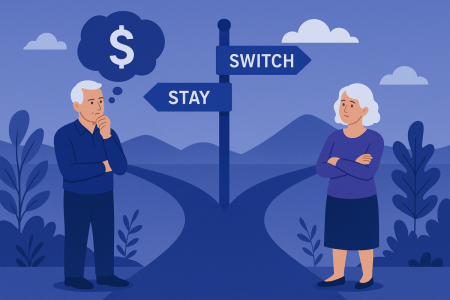Time to break up with your super fund? Retirees weigh switching providers
- Replies 0
As we settle into our golden years, many of us stick with the same superannuation or pension provider that saw us through our working life. After all, if it ain’t broke, why fix it?
But lately, over a cup of tea or at the bowling club, you might hear a new question doing the rounds: Should I switch my pension provider in retirement? It’s not exactly pub chat, but for plenty of older Aussies, it’s a surprisingly important consideration.
In this editorial, we’ll explore whether retirees should consider switching super providers – not pushing you to jump ship or stay put, but looking at what’s involved and what fellow retirees have to say.
On the other hand, perhaps you’ve heard that another fund offers better service, easier online access, or just gives you a better feeling. Maybe your fund was one of those named-and-shamed for underperformance and you’re wondering if you should take your money and run.
“Am I missing out by staying put?” you might ask. It’s not an easy decision, and there’s no one-size-fits-all answer.
The key is to weigh up the general process and considerations – the nuts and bolts of switching – rather than getting lost in the weeds of investment returns or ethical credentials (we’ll leave those debates for another day).
Switching is definitely possible. But is it worth the hassle for you? Let’s look at how it works and what to think about.
There’s nothing in the law stopping you from taking your account-based pension from Fund A and rolling it into Fund B. The SuperGuide website confirms that “the super rules allow it” as long as you follow the proper process.
That said, your funds will have a say in the matter too. Each super fund has its own rules and procedures for transfers. You’ll need to check the fund-specific rules of both your current provider and the new one – what forms to fill out, what proof of identity is needed, how long it takes, etc..
Think of it like moving house: the city (government) allows it, but each landlord (fund) might have different moving-out and moving-in checklists.
One common question is whether you can roll over an existing pension account directly into a new fund. Technically, when you’re in “pension phase” (drawing a retirement income), your account is a special beast. It’s not quite as straightforward as moving an accumulation super account (the kind you have while working).
In fact, according to super expert Garth McNally, the usual approach is to “stop” or commute your current pension, roll the money over, and then start a new pension in the new fund. In plainer terms, you often have to hit pause on your pension to move it.
Here’s why: government rules (and the ATO) generally only talk about rolling over lump sums. So, in practice, most funds will require you to:
The good news is that moving your super doesn’t have to be a nightmare of red tape. It might sound complex, but a lot of retirees report that the actual mechanics were easier than they feared. In fact, an Australian Money Magazine expert recently noted “it isn’t complicated to move superannuation funds”, explaining that often it’s just a matter of filling out a form for the new fund or using your myGov account to initiate a rollover.
And a retirement guide from Starts at 60 says getting the process underway can take just a few minutes online – simply go to your new fund’s website and fill in an online form to open an account. In other words, the paperwork itself isn’t Mount Everest. The real challenge is making the decision and timing it right.
Throughout this process, keep notes of dates and who you spoke to. Typically, the transition can be done in a matter of days or weeks, not months, especially if electronic transfer is used. Some super funds coordinate so well that you might only miss one fortnightly payment at most during the handover.
Still, it’s wise to time the switch carefully. For instance, you might initiate it right after you’ve received a pension payment, giving a buffer before the next payment is due. That way you won’t stress about a late deposit.
And what about your investments during the switch? Good question! If your current fund has you invested in shares or other assets, moving the money usually means selling those investments to convert to cash (since it’s hard to transfer assets “in specie” between different institutions).
One retiree cautions that if you have to sell everything, “the timing of the sell down may not be at a good time” and you could face a capital gains tax bill on profits. In other words, if markets are down, you’ll be cashing out at a low point; if markets are up, you might incur taxes on gains when you sell.
Unfortunately, there’s not much way around that, but it’s something to be aware of. Some funds might transfer assets directly if both old and new funds use the same investment – but that’s not common.
Bottom line: plan the move like you would a real house move – carefully and with an eye on timing. Most retirees who’ve done it successfully will tell you the paperwork was the easy part; it’s the decision and planning that take thought.
In short, the voices of experience tell us this: switching providers is doable and sometimes rewarding, but go in with eyes open. Ask questions, be cautious of anyone overly eager to get you to switch, and double-check the dollars and cents of it.
The takeaway: if you’ve done careful tax planning with your super, check how a rollover might affect it. You might want to consult a professional on this specific point, or at least do some homework on “tax components” in super. It’s a nuanced area, but crucial for those who are affected.
We’ve seen that it’s quite possible to make the change (thousands do it every year), and that it can be done in a matter of days with the right prep. We’ve also heard that it can come with some costs and complexities that shouldn’t be ignored.
So where does that leave you? Perhaps it’s best summed up as: look before you leap, but don’t be afraid to leap if it looks right. After all the research and soul-searching, the decision of whether to stay with your current provider or try a new one comes down to personal comfort and confidence.
Ultimately, ask yourself: Will switching give you greater peace of mind and benefit in your retirement, or are you more at ease sticking with the fund you know? It’s a thoughtful question to ponder as you steer your retirement journey, and only you can answer it. What do you think – is a change worth it, or not?
But lately, over a cup of tea or at the bowling club, you might hear a new question doing the rounds: Should I switch my pension provider in retirement? It’s not exactly pub chat, but for plenty of older Aussies, it’s a surprisingly important consideration.
In this editorial, we’ll explore whether retirees should consider switching super providers – not pushing you to jump ship or stay put, but looking at what’s involved and what fellow retirees have to say.
The Dilemma: Stick or Switch?
It’s a classic dilemma: better the devil you know, or is the grass greener elsewhere? Many retirees have been with one super fund for decades. You might have rolled your employer super into a pension account with that same fund and never looked back. There’s comfort in familiarity – you know their logo, their paperwork, maybe even their call centre hold music. Changing providers can feel like changing banks or long-time hairdressers – a bit daunting.On the other hand, perhaps you’ve heard that another fund offers better service, easier online access, or just gives you a better feeling. Maybe your fund was one of those named-and-shamed for underperformance and you’re wondering if you should take your money and run.
“Am I missing out by staying put?” you might ask. It’s not an easy decision, and there’s no one-size-fits-all answer.
The key is to weigh up the general process and considerations – the nuts and bolts of switching – rather than getting lost in the weeds of investment returns or ethical credentials (we’ll leave those debates for another day).
Switching is definitely possible. But is it worth the hassle for you? Let’s look at how it works and what to think about.
Yes, You Can Move Your Money (If You Want To)
First things first: is it even allowed to switch pension providers once you’re retired and drawing an income? In Australia, the answer is yes. The superannuation “portability” rules – set by the government – let you move your retirement money from one fund to another.There’s nothing in the law stopping you from taking your account-based pension from Fund A and rolling it into Fund B. The SuperGuide website confirms that “the super rules allow it” as long as you follow the proper process.
That said, your funds will have a say in the matter too. Each super fund has its own rules and procedures for transfers. You’ll need to check the fund-specific rules of both your current provider and the new one – what forms to fill out, what proof of identity is needed, how long it takes, etc..
Think of it like moving house: the city (government) allows it, but each landlord (fund) might have different moving-out and moving-in checklists.
One common question is whether you can roll over an existing pension account directly into a new fund. Technically, when you’re in “pension phase” (drawing a retirement income), your account is a special beast. It’s not quite as straightforward as moving an accumulation super account (the kind you have while working).
In fact, according to super expert Garth McNally, the usual approach is to “stop” or commute your current pension, roll the money over, and then start a new pension in the new fund. In plainer terms, you often have to hit pause on your pension to move it.
Here’s why: government rules (and the ATO) generally only talk about rolling over lump sums. So, in practice, most funds will require you to:
- Cease your current pension account (convert it back to a regular super balance, often called accumulation phase).
- Transfer that balance to the new fund (a rollover of the lump sum).
- Start a fresh pension account in the new fund, from which your regular payments will resume.
The good news is that moving your super doesn’t have to be a nightmare of red tape. It might sound complex, but a lot of retirees report that the actual mechanics were easier than they feared. In fact, an Australian Money Magazine expert recently noted “it isn’t complicated to move superannuation funds”, explaining that often it’s just a matter of filling out a form for the new fund or using your myGov account to initiate a rollover.
And a retirement guide from Starts at 60 says getting the process underway can take just a few minutes online – simply go to your new fund’s website and fill in an online form to open an account. In other words, the paperwork itself isn’t Mount Everest. The real challenge is making the decision and timing it right.
How to Switch Without the Headache (A Simple Guide)
So, suppose you’ve decided to explore a switch. How do you actually do it? Here’s a simple step-by-step overview:- Do Your Homework: First, ring up or check the websites of your current fund and the prospective new fund. Ask them about their process for transferring an account-based pension. Do they have any special forms? Any notice period for stopping your pension? Jot down the steps they give you. “You just need to follow any rules set out by fund one... and any required process of the second fund,” as SuperGuide puts it.
- Open the New Account: You’ll need a destination for your money. Typically, that means opening a new super/pension account with the fund you’ve chosen. Many funds let you do this online in a few minutes. You might have to provide proof of ID and decide how you want the money invested when it arrives (e.g. balanced, conservative, etc., or the fund’s default option).
- Commute (Stop) Your Current Pension: This sounds dramatic, but it’s basically notifying your current provider that you want to convert your pension account back to an accumulation account (or close the pension account). They’ll usually have a form for this.
Why do you need to do this? Because, as mentioned, you can generally only roll over a lump sum, which means your current pension has to be turned off so the full balance becomes a rollover-ready lump sum.
- Initiate the Rollover: Now for the actual moving of the money. In many cases, the new fund can handle this part for you – and that might be the smoothest route. “Definitely better to get the fund you are moving to to do the rollover – they will be keen to get your money,” one retiree quipped from experience. Often, when you open a new account, there’s an option or assistance to request a rollover from your old fund.
Alternatively, you can use the government’s online system via myGov: just log in, go to the ATO’s super transfer section, and request to transfer your balance to the new fund. The ATO will ping your old fund and get things moving, usually within a few days.
- Insider Tip: If you let the new fund lead the charge, you may avoid some run-around. The fund you’re leaving isn’t always in a rush – “the fund you are leaving can deliberately obfuscate and delay the process,” the same retiree warned. It shouldn’t happen in theory, but in practice some folks have felt their old provider dragged their feet. In contrast, the new fund wants your business and will usually help shepherd things along.
- Insider Tip: If you let the new fund lead the charge, you may avoid some run-around. The fund you’re leaving isn’t always in a rush – “the fund you are leaving can deliberately obfuscate and delay the process,” the same retiree warned. It shouldn’t happen in theory, but in practice some folks have felt their old provider dragged their feet. In contrast, the new fund wants your business and will usually help shepherd things along.
- Start Your New Pension: Once your money lands in the new fund (hooray!), ask the new provider to start an account-based pension with that balance. This might involve choosing your payment frequency and amount (within the government’s minimum drawdown rules). It’s essentially the final step – turning that lump sum back into a stream of income. Make sure everything is confirmed: when will your first payment come, do they have your bank details, etc.
Throughout this process, keep notes of dates and who you spoke to. Typically, the transition can be done in a matter of days or weeks, not months, especially if electronic transfer is used. Some super funds coordinate so well that you might only miss one fortnightly payment at most during the handover.
Still, it’s wise to time the switch carefully. For instance, you might initiate it right after you’ve received a pension payment, giving a buffer before the next payment is due. That way you won’t stress about a late deposit.
And what about your investments during the switch? Good question! If your current fund has you invested in shares or other assets, moving the money usually means selling those investments to convert to cash (since it’s hard to transfer assets “in specie” between different institutions).
One retiree cautions that if you have to sell everything, “the timing of the sell down may not be at a good time” and you could face a capital gains tax bill on profits. In other words, if markets are down, you’ll be cashing out at a low point; if markets are up, you might incur taxes on gains when you sell.
Unfortunately, there’s not much way around that, but it’s something to be aware of. Some funds might transfer assets directly if both old and new funds use the same investment – but that’s not common.
Bottom line: plan the move like you would a real house move – carefully and with an eye on timing. Most retirees who’ve done it successfully will tell you the paperwork was the easy part; it’s the decision and planning that take thought.
Voices of Experience: What Retirees Are Saying
Nothing beats hearing from people who’ve been there, done that. On this topic, retirees have plenty to say, and it’s not all sunshine and roses. Here are a few nuggets of wisdom (and caution) from the old-timers’ grapevine:- “Each change seems to have had a cost.” – One retiree, Gael, shared that she followed her financial adviser through several fund changes over the years. While she was content overall, in hindsight “each change” (each time they switched her into a new fund) “seems to have had a cost for the change”.
- Pressured to Switch? Be Skeptical. Some retirees recall getting nudged (or even shoved) toward switching by advisors or cold-callers. “Perhaps you should do an article on ongoing adviser fees… He did however suggest we change our pension fund to one we had never heard of and who took 1.75% out of the cash portion,” wrote one disgruntled reader,
- Lost Faith in Advisors: Following on the above, it’s no surprise some seniors take a DIY approach. “I have also experienced very poor recommendations and outcomes from ‘financial advisors’ and have sadly lost all faith in them,” says Greg, a retiree who shared his experience. Instead, he prefers to “navigate my own way through the maze” of super with help from a few trusted friends. This sentiment is out there: once bitten, twice shy.
- “It was easier than I thought.” Lest you think everyone has horror stories, plenty of retirees report positive outcomes. On some online forums and in letters to editors, you’ll find folks saying the switch went smoothly. “I was so nervous to move my pension, but honestly it was done in a week and I wondered why I hadn’t done it sooner,” said one 70-year-old in a forum discussion (a sentiment we’ve heard often, even if individual quotes vary).
- Beware the Delay Tactics: We touched on this earlier, but it bears repeating because it comes up often in retiree conversations. You request a rollover, and then… you wait. And wait. Most transfers these days happen electronically and relatively quickly (days, not weeks), but some people have encountered snail-paced responses from the fund they are leaving. “APRA is swamped with complaints” about funds taking too long to process rollovers, one commenter claimed.
In short, the voices of experience tell us this: switching providers is doable and sometimes rewarding, but go in with eyes open. Ask questions, be cautious of anyone overly eager to get you to switch, and double-check the dollars and cents of it.
Look Before You Leap: Key Considerations
By now, you have a sense of how to switch and what others have gone through. Before you leap into making a change, let’s summarise a few key considerations to keep in mind:- Fund Restrictions: Are you in a special type of fund? For example, defined benefit funds (mostly for ex-government or corporate employees) often have rules that either prevent switching or make it a really bad idea. You wouldn’t want to lose a guaranteed lifetime pension just to chase a maybe-better deal. “If you’re in a defined benefit plan, check the rules – these funds usually have restrictions on switching,” a retirement guide warns.
- Possible Loss of Benefits: Along similar lines, ensure you’re not sacrificing any perks by leaving your current fund. For instance, does your fund include some insurance cover that you still value? (Many of us in our 60s or 70s might not care about life insurance in super anymore, but double-check.) Once you’re in pension phase, you likely aren’t paying for insurance in super, but if you have any attached benefits, be aware you might lose them when you close the account.
- Tax Implications: We have to get a tad technical here, but it’s important. If your pension account has a mix of taxable and tax-free components (from different types of contributions over the years), switching could mix things up in a way you don’t intend. When you stop a pension and revert to accumulation, “all the tax components ... get blended together”, warns SuperGuide.
The takeaway: if you’ve done careful tax planning with your super, check how a rollover might affect it. You might want to consult a professional on this specific point, or at least do some homework on “tax components” in super. It’s a nuanced area, but crucial for those who are affected.
- Timing and Market Risk: As mentioned, when moving your money, there may be a day or two (or more) where you are out of the market. If the market shoots up during that time, you don’t benefit; if it tanks, lucky you – you were in cash. This is largely down to chance, but you can mitigate issues by avoiding switching during very volatile times if that worries you.
- Peace of Mind vs Potential Gain: Finally, think about the why. If you’re switching purely because you’re worried you “should” be doing something, make sure it’s grounded in fact. Are you genuinely unhappy with your current provider’s service or offerings? Did you find a clearly better product for your needs? Or did you just read a headline that made you jittery? It’s easy to feel FOMO even in retirement (“What if that other fund does so much better for me?”). But also consider the peace of mind of having everything sorted.
- Get Advice… or At Least a Second Opinion: Official wisdom often recommends speaking to a licensed financial adviser before making big changes. A good adviser can help crunch the numbers and foresee issues you might miss. “It’s recommended that you seek a financial advisor before making any final decisions to help you make an informed decision and avoid costly mistakes,” one guide says. That’s sound advice if you have a trusted advisor or can access quality, unbiased advice.
Conclusion: A Personal Choice for Your Peace of Mind
Switching pension providers in retirement is neither a sure-fire ticket to riches nor a foolish errand – it all depends on your situation. The fact that you’re even considering it means you’re an engaged, proactive custodian of your nest egg, and that’s a good thing.We’ve seen that it’s quite possible to make the change (thousands do it every year), and that it can be done in a matter of days with the right prep. We’ve also heard that it can come with some costs and complexities that shouldn’t be ignored.
So where does that leave you? Perhaps it’s best summed up as: look before you leap, but don’t be afraid to leap if it looks right. After all the research and soul-searching, the decision of whether to stay with your current provider or try a new one comes down to personal comfort and confidence.
Ultimately, ask yourself: Will switching give you greater peace of mind and benefit in your retirement, or are you more at ease sticking with the fund you know? It’s a thoughtful question to ponder as you steer your retirement journey, and only you can answer it. What do you think – is a change worth it, or not?










